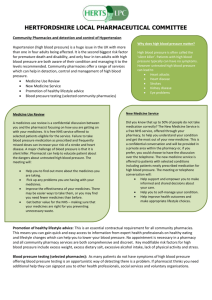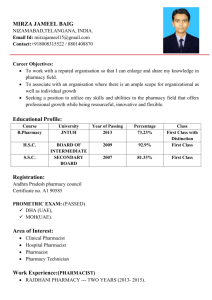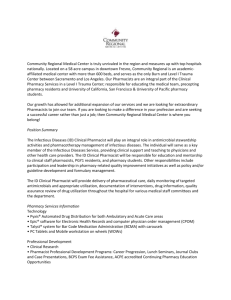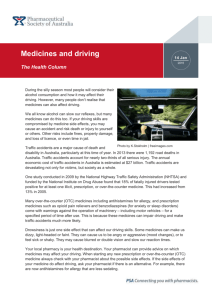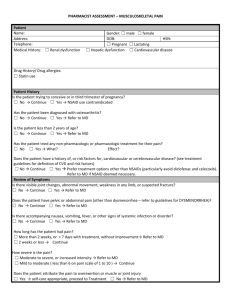Medical Faculty, University of Rwanda, Huye Campus
advertisement
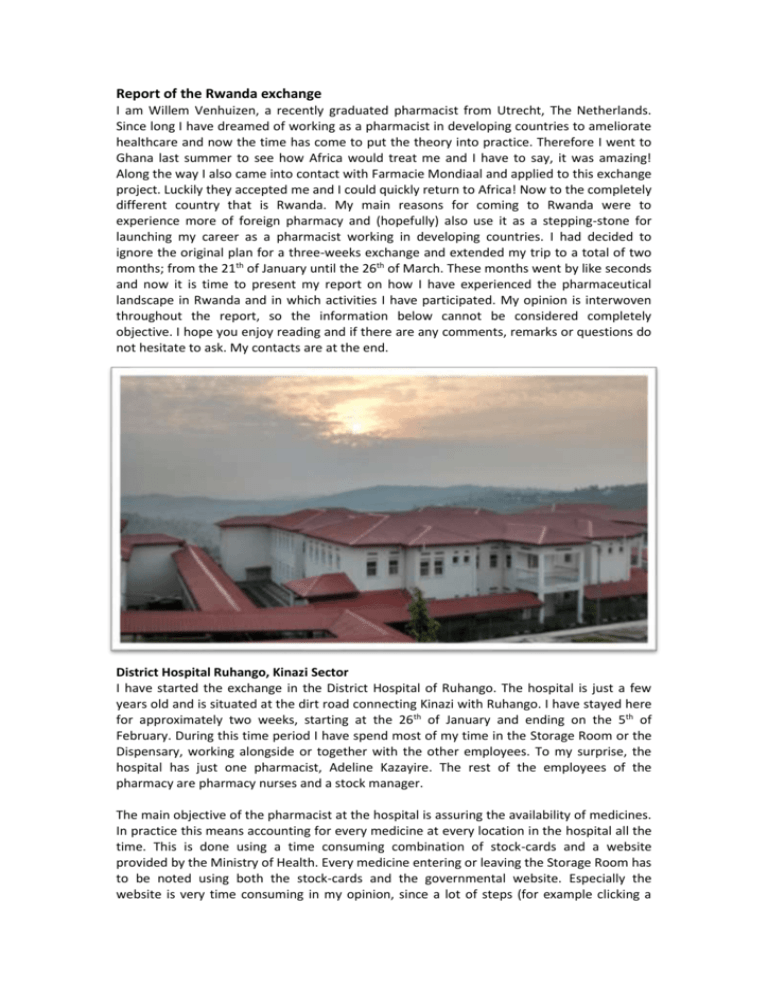
Report of the Rwanda exchange I am Willem Venhuizen, a recently graduated pharmacist from Utrecht, The Netherlands. Since long I have dreamed of working as a pharmacist in developing countries to ameliorate healthcare and now the time has come to put the theory into practice. Therefore I went to Ghana last summer to see how Africa would treat me and I have to say, it was amazing! Along the way I also came into contact with Farmacie Mondiaal and applied to this exchange project. Luckily they accepted me and I could quickly return to Africa! Now to the completely different country that is Rwanda. My main reasons for coming to Rwanda were to experience more of foreign pharmacy and (hopefully) also use it as a stepping-stone for launching my career as a pharmacist working in developing countries. I had decided to ignore the original plan for a three-weeks exchange and extended my trip to a total of two months; from the 21th of January until the 26th of March. These months went by like seconds and now it is time to present my report on how I have experienced the pharmaceutical landscape in Rwanda and in which activities I have participated. My opinion is interwoven throughout the report, so the information below cannot be considered completely objective. I hope you enjoy reading and if there are any comments, remarks or questions do not hesitate to ask. My contacts are at the end. District Hospital Ruhango, Kinazi Sector I have started the exchange in the District Hospital of Ruhango. The hospital is just a few years old and is situated at the dirt road connecting Kinazi with Ruhango. I have stayed here for approximately two weeks, starting at the 26th of January and ending on the 5th of February. During this time period I have spend most of my time in the Storage Room or the Dispensary, working alongside or together with the other employees. To my surprise, the hospital has just one pharmacist, Adeline Kazayire. The rest of the employees of the pharmacy are pharmacy nurses and a stock manager. The main objective of the pharmacist at the hospital is assuring the availability of medicines. In practice this means accounting for every medicine at every location in the hospital all the time. This is done using a time consuming combination of stock-cards and a website provided by the Ministry of Health. Every medicine entering or leaving the Storage Room has to be noted using both the stock-cards and the governmental website. Especially the website is very time consuming in my opinion, since a lot of steps (for example clicking a button) have to be repeated over and over again and could be performed a lot quicker if the website should be adjusted a little. This however is not within the ability of the pharmacist to change, since the government provides these methods and the pharmacist simply has to cope with them. It was mentioned that the use of stock-cards might not be demanded anymore (by the government) in the near future, leaving the website as the only mandatory stock keeping method. However, it remains to be seen when this time will come and if the people are able to rely on just one method. Especially since I have the feeling that the employees in the pharmacy like the strict control (correctness of quantities) they have over the medicines by using the stock-cards. Associated with assurance of availability of medicines is writing the monthly (and annual) reports. In order to make these reports, every medicine in the whole hospital has to be accounted for. This can take the pharmacist easily three or more full days in which she is mostly busy with just counting medicines. The reports are sent to the District Pharmacy (DP). The DP subsequently decides how much medicines actually will be supplied to the hospital, based on the current stock in the hospital, the movement of the medicine in the last month and the stock at the DP. These reports have to be handed over to the DP personally, because an official stamp and signature are demanded. Ideally, the hospital pharmacist is able to procure all medicines needed from the DP, but in the case of stock-outs medicine may also be procured at other places upon approval (signed and stamped document) from the DP. In practice this means that the pharmacist can easily be away from the hospital for more than half a day just to procure some medicines at another location in case of a stock-out. Since almost all (or simply all) the time of the pharmacist is occupied by stock keeping and related issues, limited time remains for pharmaceutical care. In my opinion, this is also reflected in the way medicines are dispensed in the pharmacy. Medicines are dispensed using handwritten prescriptions. These prescriptions only give information on the identity of the patient and drugs to dispense. No information is present on indications or contra-indications, nor can this information be retrieved using any medical documentation on the patient, since there is none available to the pharmacy. Laboratory tests may be executed, but results are not known to the pharmacy. The processes in the dispensary are limited to Dispensary of the District Hospital Ruhango checking the prescription for payment, filling out the necessary medication in small bags, writing the name and usage of (when to take) the medicine on the bag and telling the patient when to use the medicines. In general, no further information like possible side effects or precautions is given to the patient. There is no (digital) infrastructure or tools available for maintaining a patient file, so interactions or contra-indications can only be discovered based on the information obtained from the patient and given on the prescription. However, I doubt if this is done or if even is possible, knowing from my own experience how hard (or even impossible) it is to remember all this information and how much I am relying on the information system used in the Dutch pharmacies myself. Moreover, there is a difference in authority between doctors and pharmacists like there used to be in the Netherlands as well, making it very uncommon or maybe even undesirable for the pharmacists to question the doctors’ work. This complicates the work I think the pharmacist is responsible to do. However, I am fully aware this takes time to change. Because I think pharmaceutical care should be the core business of every pharmacist, not only because that is how I was educated, I was quiet disappointed or maybe even sad that all the pharmacist’s time was consumed by stock keeping and related business. Almost none of the knowledge or skills learned at the university are necessary for these tasks. Therefore I think I was mostly disappointed that such highly educated people are simply not able to put their knowledge into action, because all their time is consumed by other proceedings. However, I am fully aware that the country needs a solid basic healthcare system before elaborating to more complex things like pharmaceutical care. And I have to admit, they do! Almost all people have health insurance and therefore (basic) healthcare is available and affordable for everyone nowadays. Key to this is the availability of medicines and the pharmacist is doing good work on that, preventing stock-outs and doing all she can to ascertain the availability of medicines. Nonetheless, my frustrations considering that every pharmacist’s focus should be pharmaceutical care and not stock keeping led to the following recommendations. They all have to do with improving or introducing pharmaceutical care or relieving the pharmacist of administrative duties to have more time to focus on pharmaceutical care. 1. Dividing administrative duties over the pharmacy staff Goal: To make more time for the pharmacist to spend on improving the pharmaceutical care in the hospital. To-do: - Write down which administrative duties need to be done in the pharmacy (both in the Dispensary and the Storage Room) and who is responsible for those at the moment (pharmacist or pharmacy nurses) - Decide which duties currently performed by the pharmacist can also be done by a pharmacy nurse and which absolutely need to be done by the pharmacist. - Make a plan to educate the nurses on their new task to perform and plan how to evaluate the work done. 2. Pre-packing medicines for the dispensary Goal: to be able to dispense the medicines quicker and also give some additional information on these medicines. Set-up: - To pre-pack most dispensed medicines in bags with a printed instruction how to use them - Suggested medicines (based on the lists of daily dispensed drugs): o Amoxicillin 21, 30 and 42 pieces o Captopril 30 and 60 pieces o Cimetidine 400 mg 21 pieces o Cloxacillin 15, 30 and 42 pieces o ‘Fer folique’ 30 and 45 pieces o Furosemide 60 pieces o Ibuprofen 400 mg 10, 15 and 30 pieces o Indomethacine 30 pieces o Mebendazol 6 pieces - o Metronidazol 42 pieces o Nifedipine 20 mg 60 pieces o Nitrofurantoin 15 and 21 pieces o Paracetamol 15 and 21 pieces Example of pre-printed label: Amoxicillin 250 mg (42 pieces) Bibiri mu gitondo (6h) Bibiri sa sita (14h) Bibiri ni joro (22h) Don’t chew the capsules. Take them with some water To-do: - Decide which medicines are most fitted for pre-packing - Decide which quantities are most common and what is the most common prescription for them - Design labels and print them (the MUST fit in the plastic bags used for dispensing!) 3. Introducing pharmacotherapeutical meetings Goals: - To improve the (pharmaceutical) healthcare in the hospital - To achieve uniform treatment guidelines in the hospital - To have the opportunity to learn from each other Set-up: - Six meetings in a year (every 2 months) - Participants: doctors, pharmacists (and other healthcare professionals?) - Discuss a subject of interest (like common diseases), ideas: o Diabetes Mellitus (Type I and II) o Asthma o COPD o Urinary Tract Infection o Hypertension - Presentation should (at least) include: o (patho)fysiology (organs involved, mechanisms, symptoms, complications) o Treatment, treatment mechanisms, corresponding adverse drugs reactions Make use of common information sources like Rwanda Internal Medicine Clinical Treatment Guidelines, Essential Medicines List, but also look at international literature and guidelines to make the presentation Presentations can best be prepared by a doctor (for the pathophysiology) together with the pharmacist (for the treatment) - At the end there should be time for a discussion to exchange experiences and also to find consensus for the treatment guideline (!) To-do: - Make a agenda for the meetings (like the first Monday of every second month) - Decide on the topics and who will prepare which subject(s) - Arrange room for the meetings with sufficient materials like a beamer and school board District Hospital Ruhengeri, Musanze Sector The Ruhengeri District Hospital is located in Musanze, the gateway city for gorilla tracking and other activities in the Volcano National Park. Compared to Ruhango, the hospital is much older, originating from colonial times. It is also bigger with numerous disciplines scattered over the hospital’s terrain in loose buildings. The pharmacy has its own building on the terrain and is run by Jean D’Amour Nizeyimana, who is the only pharmacist employed by the hospital. I have visited this hospital for two days, just to make a (short) comparison between the two district hospitals. Since the stock-cards and the website for stock keeping are imposed by the government, these are also used in Ruhengeri. Thus in general, pharmacy is practiced in a pretty much similar manner as it is in Ruhango with the pharmacist being occupied with stock keeping or related proceedings most of his time. However concerning pharmaceutical care, some process has been made. For example there are programs for chronic diseases in which patients come to the hospital every month to receive their medication and at the same time creating time for adherence and (medical) check-ups. Another example concerns the medical meetings held four times a year. During these meetings several disciplines from the hospital come together to discuss different medical issues. A notable result is a research performed on the prescriptions of antibiotics in the hospital, which led to a more harmonised and evidence based prescription of antibiotics in the hospital. Related to the dispensing of medicines, several windows for dispensing are available so up to three patients can be served at the same time. Some medicines are prepacked in the morning to aid in the speed of dispensing. As in Ruhango, handwritten prescriptions are used, but on these prescriptions there also is space to write more information concerning examinations performed, use of medication prior to the visit and other remarks. In Prescription in the District Hospital Ruhengeri theory this is an improvement, but in practice these information is hardly used. According to the pharmacist, some sort of medical file is available for every patient and can be consulted whenever necessary. However in practice this is almost never done. The pharmacist also mentioned that in two months time a digital medical system would be implemented, but I was not able to obtain any further information on this at the time. The biggest challenges for the hospital in general are the very frequent power cuts, up to fifteen times a day is no exception, and the current state of the buildings. The buildings are old and need a lot of maintenance. Moreover, as the hospital has grown sort of organically over the years, all sorts of disciplines are scattered over the hospital’s terrain in a non-logical fashion. For example, maternity and neonatology are at opposite ends of the hospital. Concerning the pharmacy, the pharmacist is mostly troubled by stock-outs and the overall time consumption of all the administrative work. Since I have been there for just two days, I don’t have real recommendations besides storing the medicines in the dispensary booths in a more orderly fashion. When I was there, medicines were all over the (very small) place, making it very disorganised and difficult to find them sometimes. Also, litter should be put in the litterbin immediately to also keep the place more organised. University of Rwanda, Huye campus I have visited the University of Rwanda (UR) from 17th until 20th of February. On the first day I had a short meeting with the Head of Department of Pharmacy, Dr. Egide Kayitare. He explained some things about the pharmacy education. In Rwanda one becomes a pharmacist after obtaining the bachelor degree, which is a five-year program. Roughly the program is as follows: - Year 1: General knowledge together with General Medicines students - Year 2: Education on Basic skills for pharmacy - Year 3: Elaboration on the Basic skills with a Clinical view, year ends with six weeks of internship - Year 4: Elaboration on year 2 and 3 aiming at Applied skills, plus a course on entrepreneurship - Year 5: thesis and internships: o Four months hospital o Two months community pharmacy o Two months ‘regulatory’ (requisition, procurement, etc.) During these five years, three ways of obtaining knowledge are employed: theoretical, practical and self-learning. Master programs do exist but are not mandatory for practicing pharmacy. Moreover, they are few in number and hard to get into, especially concerning the costs as I did understood. Instead of becoming a ‘general pharmacist’ after your masters as happens in the Netherlands, in Rwanda one specialises in a specific field like Quality Assurance. Dr. Egide Kayitare does not think anything is missing from the curriculum, although if possible he would like to attract (big) pharmaceutical companies in order to incorporate more production or related subjects into the curriculum. At the first day I also visited the Teaching Hospital right across the street from the Medical Faculty. Here I had the opportunity to talk to one of the three pharmacists employed by the hospital. Since it was a public hospital like the others I had visited, the basics were the same. However, one exciting thing was about to start at that very moment: the introduction of the National Electronic Medical Record (EMR) system. The EMR is a system to be used by multiple disciplines in the hospital for entering medical data. Doctors can enter their findings based on examinations performed and write their prescriptions. Laboratory tests can be requested and also entered into the system. The pharmacist can retrieve the prescriptions from the system en review the information entered by other healthcare professionals. Every healthcare professional and healthcare worker shall have his or her own responsibilities, limiting the actions that can be performed in the EMR. Using this system, a medical history for every patient is created and stored at the server. At that moment, the EMR started running on the teaching hospitals’ server, but the goal is that in three years the website (the EMR) is running on servers of the MOH, making the data nationally accessible. Every patient should get their own ID number, giving healthcare professionals access to their medical history. It was not clear to me if this system will only be used in the hospitals, or also in the community pharmacies and others, but the future will point that out. If the EMR will succeed, this basically means that from one day to the next Rwanda has a more sophisticated electronic medical system than we have in the Netherlands at the moment. However, privacy might become a concern since the patient has no influence on which information can be accessed by which healthcare professional. Although, maybe privacy about their medical information is not something the Rwandese are concerned about, therefore I do not know the culture well enough to judge. The EMR as it is about to be introduced also does not generate medical safety warnings as is common to our pharmacy information systems, although this might be a feature to be introduced later into the EMR. In my opinion this can be of great importance, since non-communicable chronic diseases are on the rise with the fast developing economy and social status of the people. Medical Faculty, University of Rwanda, Huye Campus During my visit at NUR I also had the opportunity to attend two lectures, one of third grade and one with the fourth grade. Notable to the fourth grade lecture, which was about Nutrition and food quality control analysis, was that it was on a very basic level and not at all at the ‘applied level’ as fourth grades courses should be. However, this might be due to the fact that it was a sort of a ‘fill-up course’ as a student did mention, no courses on nutrition or food were given in the previous years. Something else which I found remarkable was that the lecturer giving the course was not specialised in food or nutrition, but in rather different disciplines namely epidemiology in her masters and at the moment cervical cancer as a part of her PhD. Upon asking several students, it turned out that it is common that lecturers give courses which are not necessarily related to their field of work. Moreover, no fulltime lectures are employed, making it (sometimes) difficult for students to contact them. The third grade lecture was about phytotherapy and was in my opinion mostly an enumeration of medicines extracted from plants. I personally missed the practical use for the information given. Slides with information on the analyses and extraction of different substances were incorporated into the lecture, but were skipped during the presentation. This was probably because no suitable reagents are available to perform the practicals. Since I have only attended two lectures, it is too soon to say that the study mostly focuses on knowledge and not on how to apply this knowledge, although I do tend to believe that this is the case. Concerning the practicals, these are or at least can or should be performed on the ground floor of the Ladamet Laboratory. Dr. Charles Karangwa is the director of Ladamet as well as a pharmacist and PhD in toxicology. Due to his efforts, the new building as it is present today is almost finished. Ladamet is affiliated with UR and houses equipment and materials for research and analysis on the first floor. To my knowledge, the laboratory is well equipped for research on both food and medicines, although there is still plenty of room for expansion. Research and analysis performed at Ladamet can be of a scientific as well as of a commercial nature. The lab is accessible to master students, PhDs, postdocs or other (external) professionals. Dr. Karangwa dream is for Ladamet to become self-sustainable to subsequently invest in the amelioration of education, starting from the PhD level down to the bachelors’ degree. At the moment concerning the practicals for pharmacy students, these are virtually nonexistent. The main issue is the availability of reagents and materials for the execution of the practicals. Now students are only able to watch how something is performed or maybe only get ‘a tour’ to the laboratory without anything being performed. This in contrast with the four hours of practicals a week, which on paper are incorporated into different courses. This is certainly the case for compounding, since I could not find one student (and I have asked over fifteen students) who actually did compound anything during their studies, excluding the internships in their fifth year. In my opinion this should really be improved, but it probably all will come down to money. Regarding the student body, they are organised in the Rwanda Pharmaceutical Student’s Association (RPSA). Unlike their Dutch counterparts, they do not only focus on improving and aiding in the education of students, but also on improving and promoting public health. This is expressed in collaborations with for example the Diabetes Fund and involvement in campaigns like the Tuberculosis Awareness Campaign. I was positively surprised by how active the students are and what they did and probably will achieve. Highlight of their achievements during my visit was the symposium they organised and which I attended together with over 200 other attendants from six countries including Rwanda. Kipharma, Kigali During the second part of the exchange, I spent four weeks at Kipharma in downtown Kigali. Kipharma is one of the bigger wholesalers in Rwanda, focussing mainly on brand-medicines and also houses a small production laboratory for creams, ointments and some lab reagents. It was this laboratory that I focussed on during the first two weeks. Managing director Giovanni Davite asked me to perform an audit/review on their laboratory to see which products they produce, how they do this and what should be done and invested to become (pre-) GMP. The rationale behind this request is the way the government is used to introduce high standards for companies and giving them limited time to comply and otherwise shut them down. As Kipharma is one of the three small production facilities in Rwanda, they are eager to maintain their market position. At the moment, no real production facilities or manufacturers are present in Rwanda and those that are present do not operate under international guidelines. I completed this request by asking questions to the relevant employees, mainly the lab pharmacist Serge Kamole, paying visits to the laboratory and reading any relevant documents available. This resulted in a report in which I covered the different aspects of the lab and gave recommendations for improvement. I cannot go into detail about this, as I am not allowed to share this company information without permission; therefore the report I made can also not be included in this report. The second part of the four weeks I spent on performing a small market research in order to find out if there is a market for more sophisticated dermatological products than just vaseline. This involved visiting different pharmacies and beauty shops around town, talking to doctors and dermatologists and performing a (very) small-scale survey at the pharmacy of Kipharma to find out what the opinion of the clients and the professionals is about the products. Again, I am not able to go any further in detail due to the secrecy of company information. Summary As I did come to Rwanda to experience more of foreign pharmacy and to see how they cope with their (limited) resources, it is safe to say that there is strong fundament for the basic healthcare. Most of the people are covered by health insurance and real effort is put in an organised system for procurement and management of medicines. This system for procurement and management of medicines however demands (too) much time of the pharmacists, who are low in number anyway in the hospitals, leaving virtually no time for pharmaceutical care. Probably this will be solved in time and mostly by money, but exciting first steps are taken place already with the introduction of the EMR in the Teaching Hospital in Huye. Concerning the pharmacy education, this mostly is limited by a lack of resources (reagents and materials for practicals and thus money) and it is difficult to say how or when this can be resolved. I tend to believe that the education mostly focuses on gaining knowledge and not necessarily on learning how to apply it, but the students as they associated themselves in the RPSA do a really good effort of finding ways to use their knowledge and at the same time giving back to the community. Regarding the production of medicines in Rwanda, this is really at the basic level. Meaning that there is plenty of room for investment, as long as someone is willing to do this. Acknowledgments Since I came as a lonely stranger to Rwanda and left with a lot of new friends and acquaintances, I also have a lot of people to thank. First and foremost Adeline Kazayire, my supervisor during this trip and surrogate mother when I needed a place to stay near the hospital and had to got my knee disinfected after falling off the moto. From the Ruhango hospital I also would like to thank Charlotte and Dany, for keeping me company and showing me more than just the hospital. At the Ruhengeri hospital, my thanks go to mister Jean D’Amour Nizeyimana for taking me in for just the two short days. At the university, I would like to thank Dr. Egide Kayitare, Dr. Charles Karangwa and Dr. Ernest (sorry, I never thought to write down your full name) for selflessly taking the time to show me around and tell me more about what you do. I also would like to thank the students of the RPSA, with special thanks going to Israel Bimpe, Janvier Kabogo, Mandela Elie and Claude Mutabazi for inspiring me what you can achieve and for becoming real friends. At Kipharma, my thanks go to Giovanni and Giancarlo Davite, the directors of Kipharma for giving me two exciting assignments on which I really had to crack my brains. Of course I cannot forget Serge Kamole, the man I have interrogated with a thousand questions and always remained friendly and patient. And lastly but certainly not least, my thanks go to Lambert Kadende, Dudu, Annick, Yvonne and Antoinette for giving me guidance or just taking the time to have a little chat. Thank you! Willem Venhuizen willemvenhuizen@gmail.com https://www.facebook.com/willem.venhuizen
